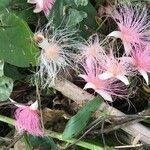Tree 2–12(–27) m. tall, with grey and yellow, greyish or yellowish-brown smooth or fissured bark, sometimes with pneumatophores as in mangroves; bark on young branches very tough; leaf-scars conspicuous; crown with spreading branches.. Leaves shortly petiolate; blades obovate-oblong, or usually elliptic, to elongate-oblanceolate, (5–)15–36(–42) cm. long, (2–)6–14(–16) cm. wide, acuminate at the apex, cuneate at the base, often rounded at the extreme base, glabrous, crenulate; petiole 0.25–1.5 cm. long.. Flowers many in pendulous racemes 20–70(–100) cm. long; pedicels 0.3–1.6(–2.5) cm. long.. Calyx green, mostly flushed pink or deep purple, splitting into (2–)3–4(–5) lobes, 0.75–1.5 cm. long, 0.5–1.25 cm. wide.. Petals white, often tinged pink outside, elliptic, 1.2–3 cm. long, 0.5–1.5 cm. wide, adnate to the staminal tube.. Stamens white or pinkish tinged, numerous, in several rows, 2.2–3.7(–5) cm. long.. Ovary ± globular, (2–)3–4(–6, fide Kirk)-locular; ovules 2–3 in each locule; style red, (2–)3–6.2 cm. long.. Fruit ± ellipsoid or conic, round in section or sometimes distinctly angular, 3–7(–9) cm. long, 2–4(–5.5) cm. wide, scarcely glossy, mostly dull and rather rough; endocarp fleshy-fibrous.. Seed ovoid or subtetragonous, 2–4 cm. long, 1–2.5 cm. wide.. Fig. 1/1–7.
Shrub or tree to 30 m high, evergreen or briefly deciduous. Bark smooth or fissured. Leaves: lamina obovate-oblong to obovate-lanceolate or narrowly elliptic, 10–42 (–47) cm long, 4–16 (–19) cm wide, cuneate at base, serrate-crenulate margin, acute or acuminate at apex, glabrous; petiole 2–15 mm long, narrowly winged. Racemes usually terminal, pendulous, many-flowered; pedicels up to 25 mm long; bracts triangular, 5–6 mm long; bracteoles triangular, 1.5–2 mm long. Bud 6–9 mm long. Calyx rupturing into 2–5 almost equal elliptic lobes 7–15 mm long and tube 2–5 mm long. Petals 4 (or 5), elliptic, 15–25 mm long, white or cream, or tinged red or yellow. Stamens numerous, in 5 or 6 whorls, the innermost sterile; tube 3.5–6 mm long; filaments 22–40 mm long, white or pink below; staminodes 10–13 mm long. Ovary 2–4-locular, 1.5–3.5 mm long; ovules 2 or 3 per locule; style 2–5.5 cm long. Fruit ovoid, tetragonous, 4.5–9 cm long, 2–4 cm wide, green to brown; pericarp fibrous but somewhat fleshy. Seed 1, ovoid, 2–4 cm long.
Shrubs or trees to 27 m tall. Branches pendulous, gray-brown; bark smooth or fissured. Leaves petiolate; petiole 2-15 mm, winged; leaf blade obovate-oblong, 20-35 × 6-14 cm, base cuneate, margin serrate-crenulate, apex acute or acumi-nate. Racemes usually terminal or in axils of fallen leaves, pendulous, many flowered; bracts triangular, 5-6 mm; bracteoles triangular, 1.5-2 mm. Pedicel to 2.5 cm. Flowers 6-9 mm. Calyx 2-4-lobed, 10-12 cm at anthesis; tube ca. 2.5 mm. Petals 4, green or tinged red or yellow, oblong, 1-1.3 × 0.5-0.8 cm. Stamens in 5 or 6 whorls, innermost sterile; tube 3.5-6 mm; filaments red, proximally white or pink, 3-3.5 cm; staminodes 10-13 mm. Ovary 2-4-loculed, 1.5-3.5 mm; ovules 2 or 3 per locule; style 4-6 cm. Fruit ovoid-cylindric, 4-angled, 5-9 × 3-4 cm; pericarp fibrous but somewhat fleshy. Seed ovoid, 2-4 cm. Fl. and fr. almost year-round. 2n = 52.
A small evergreen tree or shrub reaching a height of 10-16 m. It spreads to 5 m across. The stem is erect and branching. The tree has a rounded crown. The leaves are crowded at the ends of the branches. They are dark green and 25 cm long by 2-3 cm wide. Leaves can be twice this size. They are pointed at both ends and with toothed edges. The branches are marked with leaf scars. The flowers are white or pink and about 2 cm across. They occur in hanging stalks with individual flowers along the stalk. These stalks can be 25 cm long. The fruit hang along these stalks. The fruit is oblong to oval and somewhat 4 angled. Fruit can be 8 cm long and 2-5 cm wide. They are oval and irregular. They are green or purple. They contain only one seed.



